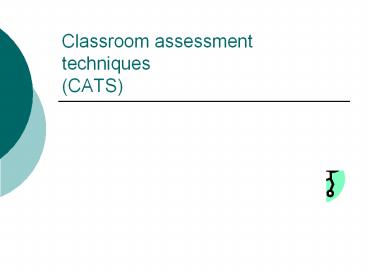Classroom assessment techniques (CATS) - PowerPoint PPT Presentation
Title:
Classroom assessment techniques (CATS)
Description:
Liberal arts and academic values. Career prep. Personal development. Reflective: why ... Liberal arts and academic values. Conditional: when/where ... – PowerPoint PPT presentation
Number of Views:166
Avg rating:3.0/5.0
Title: Classroom assessment techniques (CATS)
1
Classroom assessment techniques(CATS)
2
What are CATS?
- How many of you have seen this book before?
Please put your hands up. - Congratulations! You just completed a CAT.
- A simple method faculty can use to collect
feedback, early and often, on how well students
are learning what they are being taught.
3
Why are CATS?
- We use CATS to assess progress toward our
teaching goals. - Please take a few minutes to complete the
Teaching Goals Inventory, with a particular
course in mind.
4
Why are CATS?
Dimensions of learning Teaching goals inventory Bloom taxonomy
Declarative what Discipline specific knowledge Knowledge Comprehension
Procedural how Basic academic success skills Discipline specific skills Comprehension Application
Conditional when/where Higher order thinking skills Liberal arts and academic values Application Analysis Synthesis
Reflective why Higher-order thinking skills Liberal arts and academic values Career prep Personal development Analysis Synthesis Evaluation
5
Why are CATS?
Dimensions of learning Teaching goals inventory Bloom taxonomy
Declarative what Discipline specific knowledge Knowledge Comprehension
Procedural how Basic academic success skills Discipline specific skills Comprehension Application
Conditional when/where Higher order thinking skills Liberal arts and academic values Application Analysis Synthesis
Reflective why Higher-order thinking skills Liberal arts and academic values Career prep Personal development Analysis Synthesis Evaluation
6
Example 1Declarative knowledge
- The one-minute exercise
- List as many of the six levels of Blooms
taxonomy as you can. Compare your list with your
neighbor and add ones you may have left out. - Variations
- List 3 main points of todays lecture.
- What was the muddiest point in my lecture?
7
Why are CATS?
Dimensions of learning Teaching goals inventory Bloom taxonomy
Declarative what Discipline specific knowledge Knowledge Comprehension
Procedural how Basic academic success skills Discipline specific skills Comprehension Application
Conditional when/where Higher order thinking skills Liberal arts and academic values Application Analysis Synthesis
Reflective why Higher-order thinking skills Liberal arts and academic values Career prep Personal development Analysis Synthesis Evaluation
8
Example 2Procedural knowledgeBasic academic
skills
- One-word journals
- Choose a single word to summarize the following
paragraph. Be prepared to explain your word
choice to your neighbor.
9
- The purpose of Classroom Assessment is to
provide faculty and students with information and
insights needed to improve teaching effectiveness
and learning quality. College instructors use
feedback gleaned through Classroom Assessment to
inform adjustments in their teaching. Faculty
also share feedback with studentsto help them
improve their learning strategies and study
habits to become more independent, successful
learners.
10
Why are CATS?
Dimensions of learning Teaching goals inventory Bloom taxonomy
Declarative what Discipline specific knowledge Knowledge Comprehension
Procedural how Basic academic success skills Discipline specific skills Comprehension Application
Conditional when/where Higher order thinking skills Liberal arts and academic values Application Analysis Synthesis
Reflective why Higher-order thinking skills Liberal arts and academic values Career prep Personal development Analysis Synthesis Evaluation
11
Example 3Conditional knowledgeApplication,
Analysis
- Compare and contrast the one-minute paper and the
one-word journal. - Are they equally usable in class vs. for
homework? - Are they equally good at assessing
discipline-specific skills vs. study skills? - Are they equally easy for the teacher to prepare?
- Do they equally lend themselves to peer
interaction? - Are they equally easy to expand into a larger
assignment if desired?
12
Why are CATS?
Dimensions of learning Teaching goals inventory Bloom taxonomy
Declarative what Discipline specific knowledge Knowledge Comprehension
Procedural how Basic academic success skills Discipline specific skills Comprehension Application
Conditional when/where Higher order thinking skills Liberal arts and academic values Application Analysis Synthesis
Reflective why Higher-order thinking skills Liberal arts and academic values Career prep Personal development Analysis Synthesis Evaluation
13
Example 4Reflective knowledgeSynthesis,
Self-awareness
- Concept map
- Brainstorm ideas related to the concept
Classroom Assessment - Put Classroom Assessment in the middle of a
page, and then show how the other ideas are
linked to it, e.g. as spokes of a wheel, or as a
set of concentric circles, or as a network or
road map. Label the links. - Be prepared to share your map with your neighbor,
and to discuss similarities and differences.
14
Example 5Reflective knowledgePersonal/Career
Development
- Look at your Teaching Goals Inventory and select
one of your goals for your class. Draft a
paragraph describing how this goal could be
assessed in a class activity. You may use one of
the CATS we have discussed, or invent your own!
15
Example 6Reflective knowledgeEvaluation
- Classroom opinion poll/Assignment evaluation
- Please number an index card from 1 to 3. For
each of the following statements, please write
whether you agree, are neutral or disagree.
16
- The activities in this session have helped me
learn about CATS - This session has added to my self-awareness of my
goals as a teacher - This session has encouraged me to begin or
continue to use CATS
17
Sources
- Angelo, T. A. Cross, P. (1993) Classroom
Assessment Techniques (2nd ed.). SF Jossey-Bass. - Angelo, T. A.(1991). Classroom research Early
lessons from success. New Directions for
Teaching and Learning (46). SF Jossey-Bass. - McGovern, T. Classroom Assessment Strategies.
Handout used in Developing Teachers of
Psychology pre-conference workshop for American
Psychological Association.































